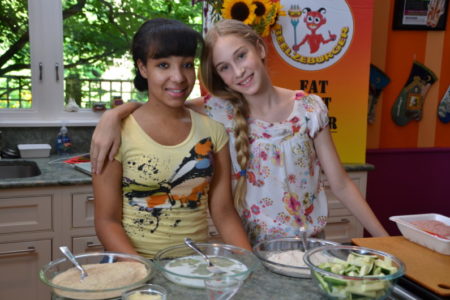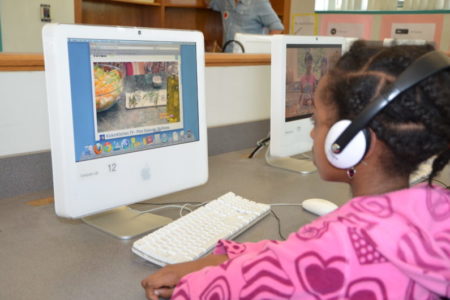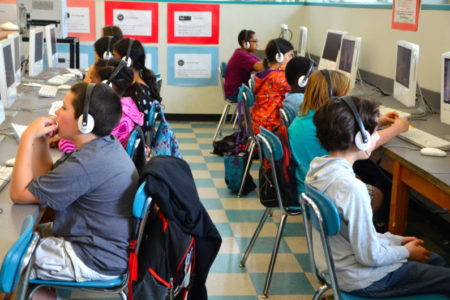Share On Social!
School lunches and snacks are becoming more nutritious thanks to improved federal nutrition regulations—but this is only part of the school food solution. Nutrition education for kids is a critical component. One seasoned children’s TV producer, who witnessed the childhood obesity epidemic as she raised her own kids, had an idea to use new technology to engage kids in learning about healthy living. Because of her, thousands of kids in Massachusetts, New York, and Florida have begun learning through KickinNutrition.TV, a digital platform for teachers to use to instruct students on healthy eating habits and exercise through videos, online gaming, and a social-media-like engagement designed for elementary- and middle-schoolers.
EMERGENCE
Awareness/Learn: Natasha Lance Rogoff worked as a children’s TV producer for Sesame Street International, creating 182 episodes in Mexico and Russia.
After spending time abroad for her job, she moved back to the United States with her two young kids.
She soon noticed a growing trend of unhealthy habits in America, with poor nutrition and obesity. She continued to witness this trend as her kids entered middle school, where policies and educational programs to support nutrition education and the building of healthy school environments were limited.
“Kids are not happy being overweight,” Rogoff says. “It affects their performance in school, it affects their self-esteem, and when we started talking to students in inner-city schools about what kind of nutrition education they get, many replied that it was boring or didn’t exist. There was a big gap in what was being provided during formative years when kids are just beginning to make food choices on their own.”
 Frame Issue: Rogoff wanted to improve nutrition and wellness education in schools.
Frame Issue: Rogoff wanted to improve nutrition and wellness education in schools.
Because she worked in children’s TV, she knew what kinds of educational entertainment were appealing to kids. She decided to try and capitalize on this experience to find a new way to educate kids about healthy eating and the importance of physical activity, while connecting to them in this digital age.
DEVELOPMENT
Education/Mobilization: Rogoff began to gather friends and colleagues in the production industry to see if they could get traction on creating videos to educate kids about nutrition and exercise.
She explained to the team how new technologies—hi-definition cameras, inexpensive software, interactive gaming, and digital platforms—could be harnessed to enhance children’s learning of healthy lifestyles.
In early 2010, Rogoff brought together producers, nutrition, medical and education experts, composers, and animators to create KidsCOOK Productions to brainstorm innovative approaches to reach kids digitally and move them to make changes in their eating and exercise behaviors.
The team met on weekends to develop episode story lines, lyrics for original music, characters, and concepts for the educational interactive platform.
 Debate: The team started creating videos and a digital platform they hoped to deliver to children in schools.
Debate: The team started creating videos and a digital platform they hoped to deliver to children in schools.
The videos and digital platform would feature nutrition education curricula taught by teens in partnership with teachers. Interesting, vibrant content is a key to appealing to the digital generation of kids who frequently change behaviors in response to technology and media, Rogoff said.
“A lot of the materials that exist are flat materials, and are kind of boring,” Rogoff said. “So what we tried to do was make nutritional literacy and the preparation and cooking of healthy food something that would excite and inspire kids…something that kids would want to celebrate and share.”
The team designed video content for kids in grades 4-8 and edited them to fit the length of a single class so teachers could easily fit the program into their classroom or after-school program schedule.
ENACTMENT
Activation: Rogoff and the KidsCOOK Productions team applied for and received a USDA-NIFA-SBIR grant to allow them to create and test the videos and other materials in schools.
The grant allowed them to start producing videos for a pilot test in local Cambridge, Mass., schools. This test would provide feedback from teachers and students on how well the program fit into their school day and evaluate impact related to eating and wellness choice changes.
The videos, KickinNutrition.TV (KNTV) program includes digital videos, in-class activities, and physical activity breaks, where students are led in a video to get up and move around.
Another part of the program is the interactive game, StudenTopia that students get to play outside of class and continue learning about healthy eating with their friends and family. StudentTopia also features healthy, kid-friendly recipes with step-by-step videos showing kids how to get started in the kitchen.
KNTV videos feature young people talking about healthy living habits.
Simone Senibaldi, a young Latina from Everett, Mass., stars in the series as “Reyna” because of the importance of featuring a diverse cast because of the growing Latino population, Rogoff said.
“Being a part of it has taught me so much about food, and being healthy, and I’ve even changed the way that I’ve been eating,” Senibali said. “It’s opened up my eyes to so many new ways to eat and stay healthy, but also have fun.”
 Frame Policy: Initial feedback from pilot-test students and teachers was very positive.
Frame Policy: Initial feedback from pilot-test students and teachers was very positive.
Teachers appreciated that the program was completely put together and digital, meaning they did not have to do much prep work to give their students positive education about eating right and exercising.
The digital and interactive aspects of the program make it unique, Rogoff said.
For example, the online platform gives each student their own username and password to access the site from both school and home. Students can log-on any time to re-watch videos, play StudenTopia, find recipes, connect with classmates, and find more information to share with their families.
Students, like fifth-grader Caleb from one of the Cambridge pilot schools, said the KNTV activities helped him learn through interactive games and in-class activities.
“I learned about balanced meals, which I didn’t know before,” Caleb said in a testimonial on the KNTV website. “I would really like to recommend this game to my friends, because it’s kind of up my alley, and my friends like the same kind of game.”
The KNTV team, with a successful pilot test in tow, wanted to expand the program to other schools.
They decided to bring the program to Harlem Village Academies (HVA), a group of Title 1-funded charter schools in Harlem, N.Y. Title 1 is a federally funded program that assists schools with high populations of students from low-income families. About one-third of students who are considered eligible for Title 1 funding are Latino.
Change: In summer 2013, HVA leaders decided to implement KNTV in their 5th and 6th grades.
With the program now at HVA and the ongoing testing in Massachusetts, more than 2,000 will have received digital nutrition education in 2013-14.
IMPLEMENTATION
Implementation: In fall 2013, students in HVA and other locations were trained to implement a full program of six 40-minute lessons from KNTV.
Teachers can show each lesson during a full class or break them up into smaller video segments.
“I’ve been using the KickinNutrition curriculum with my 5th graders…it’s so well-tailored to the age group. It’s very interactive. Kids are moving, kids are doing activities,” explains Paul LoFaso, P.E. teacher in Harlem. “If they didn’t hear it in the lessons they probably wouldn’t hear it ever.”
The videos and lessons are all available online, assessable to teachers/schools with an account and password.
They can also download other materials and activities to do with their class. If schools do not have Internet abilities, KickinNutrition.TV is available on DVD to show on TVs in class.
“The way that the program is structured it minimizes preparation time and maximizes quality time with the teachers and doing in-class activities, which yields a higher level of engagement and greater retention of the lessons—precisely because the program combines digital media and hands-on learning” Rogoff said.
 Equity: The HVA curriculum implementation was a success, Rogoff said.
Equity: The HVA curriculum implementation was a success, Rogoff said.
At HVA, where 71% of students receive a free or reduced lunch (which means they get one or more of their meals at school), teaching them healthy eating habits is very important and reinforces the new healthy meal standards.
“The kids love the energy, the animation, they just love being a part of it. And not only that but also getting the nuts and bolts of essential nutrition so we definitely love it here at HVA middle school. In terms of nutrition, I think that this is a very nice platform to be able to use. It’s very interactive, it’s easy to use,” says Jason McFall, a P.E. teacher from Harlem. “And they’re able to learn a little bit more than they would from reading it in a book; and hopefully, it will resonate later. I think this is going to be the new wave. The kids love it and I’m definitely two thumbs up for it.”
To continue providing the program to schools that need free nutrition and physical education, Rogoff founded a charity organization in partnership with Filmmaker’s Collaborative, a nonprofit called “Ingredients for Education.” The nonprofit will ensure that the KNTV program is in place for a second year and expects that the program will remain at HVA schools well into the future.
Future plans include the creation of a bilingual curriculum and expansion into more schools.
Sustainability: Beginning in spring 2015, the KNTV program will be implemented in 23 Pinellas County Schools in Tampa, Fla., a school district with at 14.4% Latino population and a 5th-grade population of 7,000 students and 70 teachers each year. KNTV also plans to evaluate the program impact.
Title 1 schools can apply to receive the program for free through the Ingredients for Education nonprofit. The curriculum also is available for purchase through KickinNutrition.
Update: 10-23-15
Recently KickinNutrition.TV has gained popularity with The Huffington Post and Metro Boston, revealing the show as a revolutionary way to connect kids with healthy foods.
The Mario Batali Foundation announced support to distribute KNTV for no cost for New York City Title 1 schools during 2015-2016 years, along with generous support from the Heckscher Foundation for Children.
The program has been so successful in reaching students that Apple has partnered up to feature the show at an event in Boston! To register or learn more about the Apple store event, click here !
Additional Links:
The WeWalk Website
WeWalk Youtube Video and Estrella’s YouTube Channel
This success story was produced by Salud America! with support from the Robert Wood Johnson Foundation.
The stories are intended for educational and informative purposes. References to specific policymakers, individuals, schools, policies, or companies have been included solely to advance these purposes and do not constitute an endorsement, sponsorship, or recommendation. Stories are based on and told by real community members and are the opinions and views of the individuals whose stories are told. Organization and activities described were not supported by Salud America! or the Robert Wood Johnson Foundation and do not necessarily represent the views of Salud America! or the Robert Wood Johnson Foundation.
ABOUT THE PROGRAM
Salud America! The RWJF Research Network to Prevent Obesity Among Latino Children is a national program of the Robert Wood Johnson Foundation. The program aims to educate researchers, decision-makers, community leaders, and the public in contributing toward healthier Latino communities and seeking environmental and policy solutions to the epidemic of Latino childhood obesity. The network is directed by the Institute for Health Promotion Research at the University of Texas Health Science Center at San Antonio.
For more information, visit http://www.salud-america.org.
By The Numbers
142
Percent
Expected rise in Latino cancer cases in coming years
This success story was produced by Salud America! with support from the Robert Wood Johnson Foundation.
The stories are intended for educational and informative purposes. References to specific policymakers, individuals, schools, policies, or companies have been included solely to advance these purposes and do not constitute an endorsement, sponsorship, or recommendation. Stories are based on and told by real community members and are the opinions and views of the individuals whose stories are told. Organization and activities described were not supported by Salud America! or the Robert Wood Johnson Foundation and do not necessarily represent the views of Salud America! or the Robert Wood Johnson Foundation.



